Analysis of Tort Law Principles and Breach of Duty
VerifiedAdded on 2020/10/22
|9
|3301
|281
Report
AI Summary
This report examines a case study involving Gina, Samuel, and Claire, analyzing their actions within the framework of tort law. The report identifies breaches of civil duty, including Gina's negligence in pesticide handling leading to damage to Samuel's roses and the disturbance caused by her cockerel. It discusses the legal principles of negligence, intentional tort, and strict liability, referencing relevant case law such as "Donoghue v. Stevenson" and "Bill Geeslin in Bill v. Kobe Bryant". The analysis focuses on establishing duty, breach of duty, causation, and injury to determine the appropriate application of tort law. The report concludes that Gina's actions constitute negligence, making her liable for damages. It also addresses Samuel's actions, suggesting they are not justifiable. The report emphasizes the importance of balancing private rights with legal obligations and responsibilities within civil society.
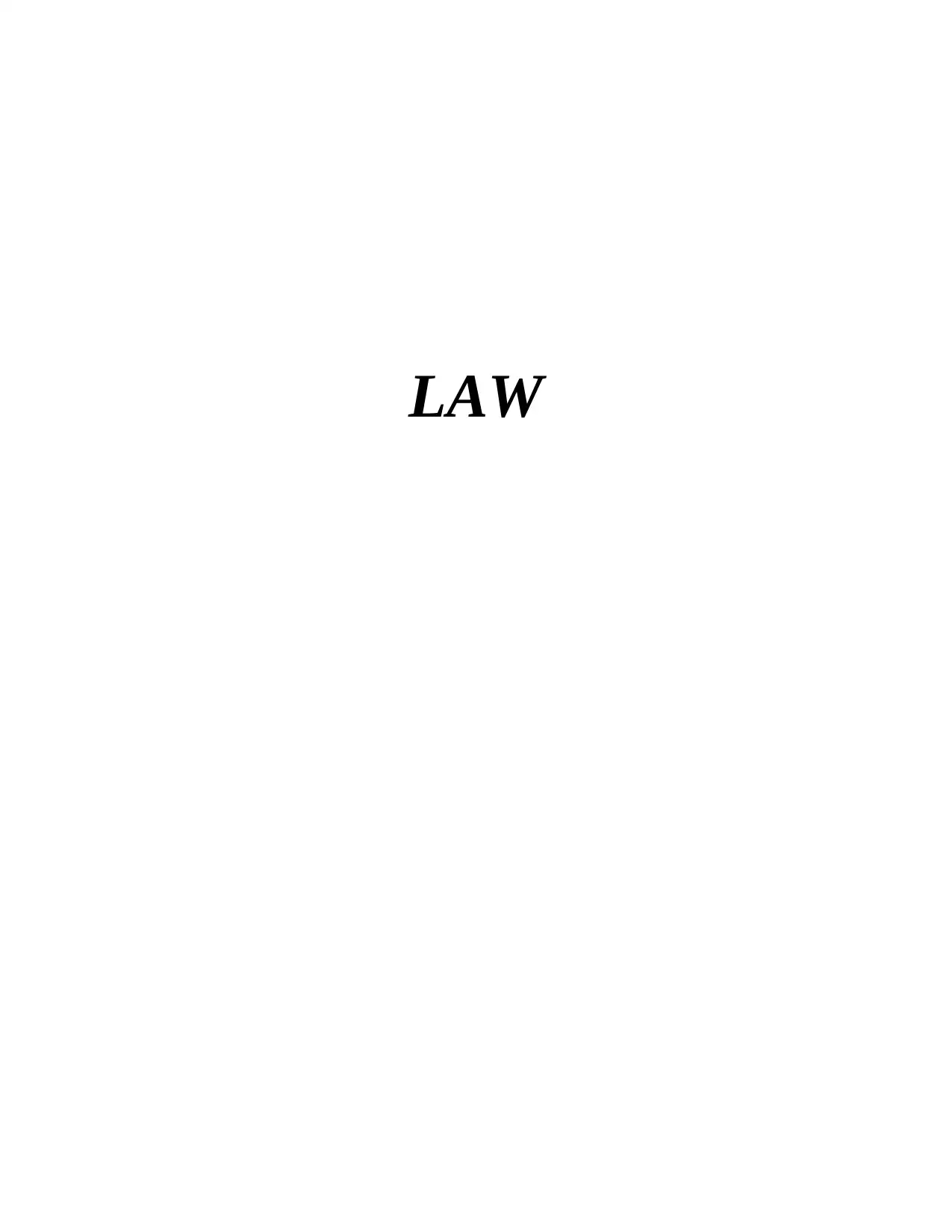
LAW
Paraphrase This Document
Need a fresh take? Get an instant paraphrase of this document with our AI Paraphraser
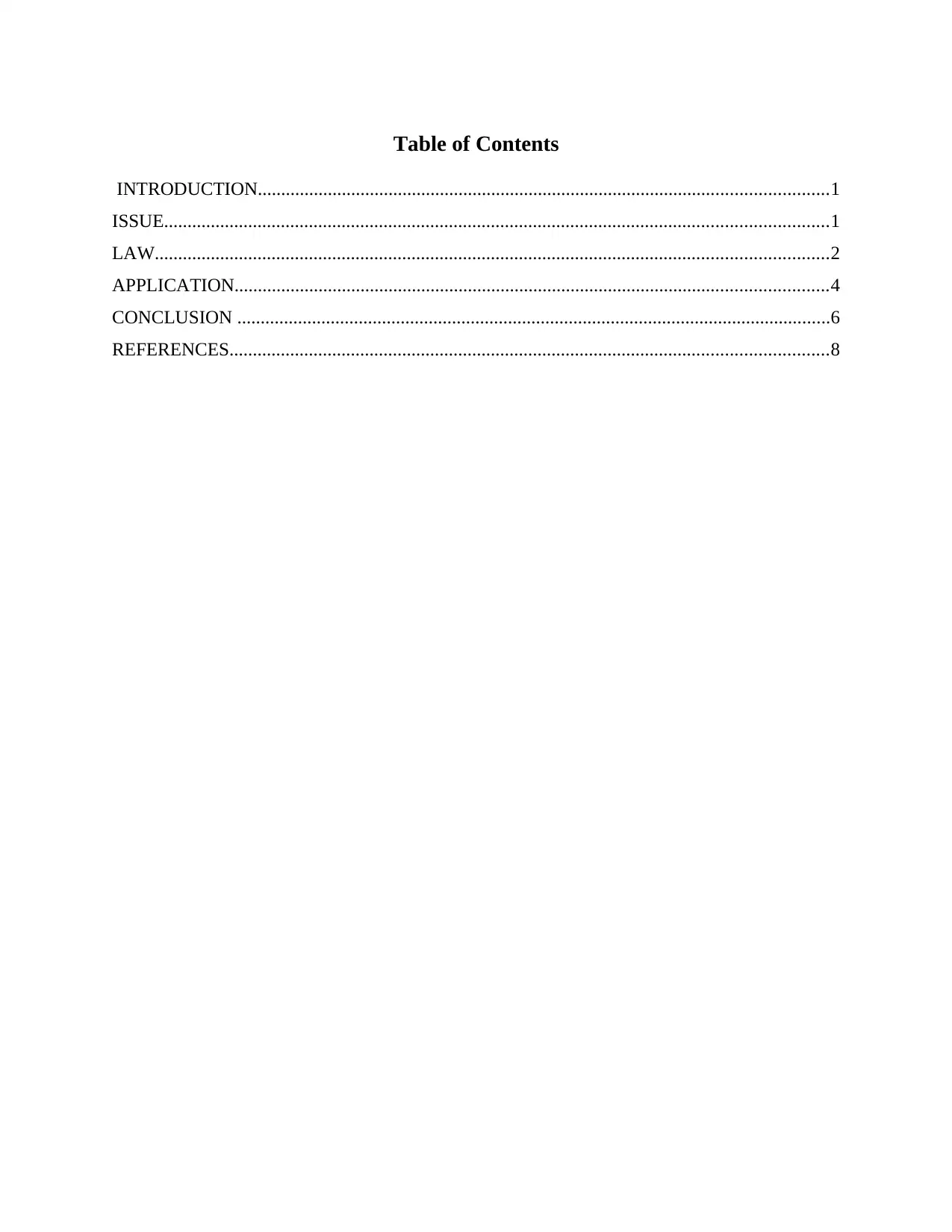
Table of Contents
INTRODUCTION..........................................................................................................................1
ISSUE..............................................................................................................................................1
LAW................................................................................................................................................2
APPLICATION...............................................................................................................................4
CONCLUSION ...............................................................................................................................6
REFERENCES................................................................................................................................8
INTRODUCTION..........................................................................................................................1
ISSUE..............................................................................................................................................1
LAW................................................................................................................................................2
APPLICATION...............................................................................................................................4
CONCLUSION ...............................................................................................................................6
REFERENCES................................................................................................................................8
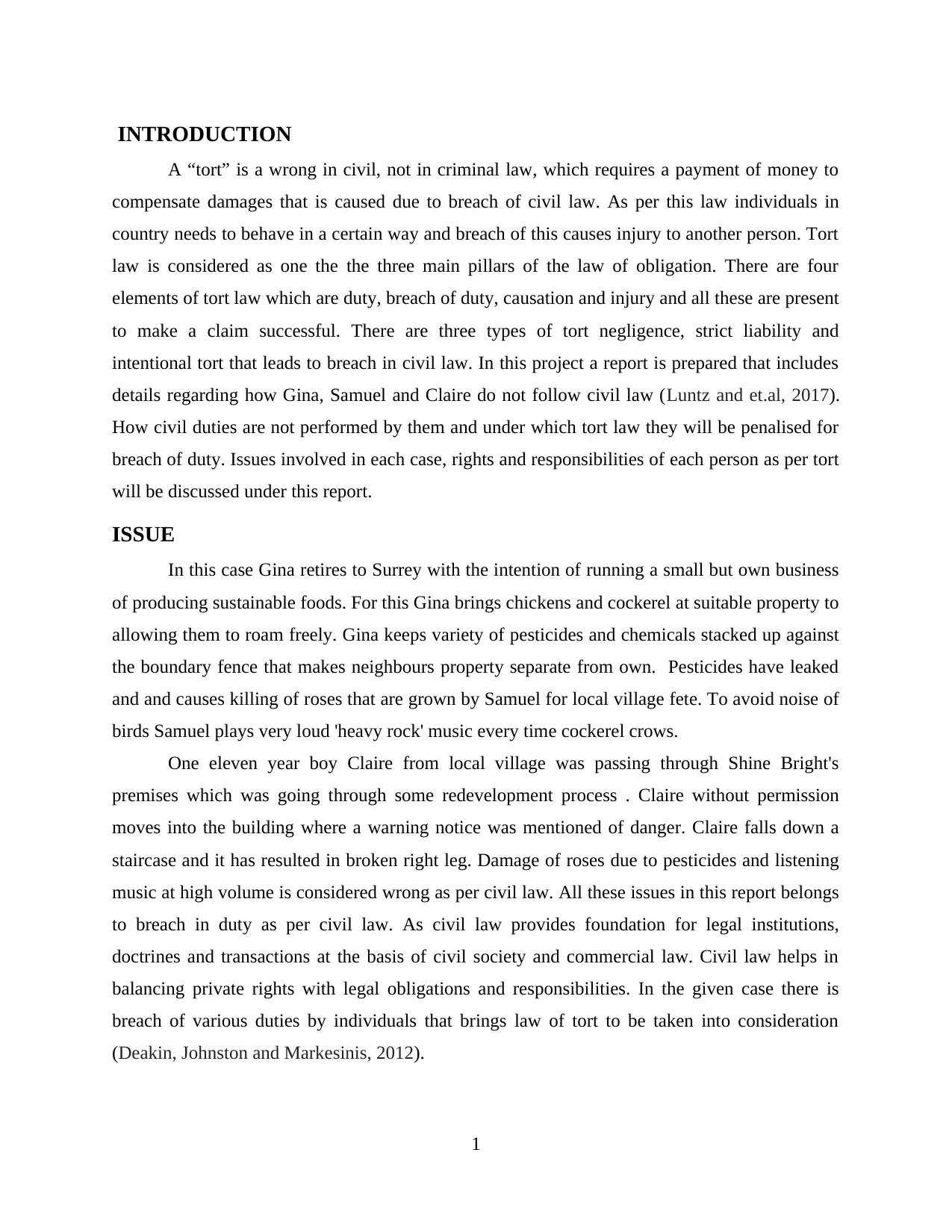
INTRODUCTION
A “tort” is a wrong in civil, not in criminal law, which requires a payment of money to
compensate damages that is caused due to breach of civil law. As per this law individuals in
country needs to behave in a certain way and breach of this causes injury to another person. Tort
law is considered as one the the three main pillars of the law of obligation. There are four
elements of tort law which are duty, breach of duty, causation and injury and all these are present
to make a claim successful. There are three types of tort negligence, strict liability and
intentional tort that leads to breach in civil law. In this project a report is prepared that includes
details regarding how Gina, Samuel and Claire do not follow civil law (Luntz and et.al, 2017).
How civil duties are not performed by them and under which tort law they will be penalised for
breach of duty. Issues involved in each case, rights and responsibilities of each person as per tort
will be discussed under this report.
ISSUE
In this case Gina retires to Surrey with the intention of running a small but own business
of producing sustainable foods. For this Gina brings chickens and cockerel at suitable property to
allowing them to roam freely. Gina keeps variety of pesticides and chemicals stacked up against
the boundary fence that makes neighbours property separate from own. Pesticides have leaked
and and causes killing of roses that are grown by Samuel for local village fete. To avoid noise of
birds Samuel plays very loud 'heavy rock' music every time cockerel crows.
One eleven year boy Claire from local village was passing through Shine Bright's
premises which was going through some redevelopment process . Claire without permission
moves into the building where a warning notice was mentioned of danger. Claire falls down a
staircase and it has resulted in broken right leg. Damage of roses due to pesticides and listening
music at high volume is considered wrong as per civil law. All these issues in this report belongs
to breach in duty as per civil law. As civil law provides foundation for legal institutions,
doctrines and transactions at the basis of civil society and commercial law. Civil law helps in
balancing private rights with legal obligations and responsibilities. In the given case there is
breach of various duties by individuals that brings law of tort to be taken into consideration
(Deakin, Johnston and Markesinis, 2012).
1
A “tort” is a wrong in civil, not in criminal law, which requires a payment of money to
compensate damages that is caused due to breach of civil law. As per this law individuals in
country needs to behave in a certain way and breach of this causes injury to another person. Tort
law is considered as one the the three main pillars of the law of obligation. There are four
elements of tort law which are duty, breach of duty, causation and injury and all these are present
to make a claim successful. There are three types of tort negligence, strict liability and
intentional tort that leads to breach in civil law. In this project a report is prepared that includes
details regarding how Gina, Samuel and Claire do not follow civil law (Luntz and et.al, 2017).
How civil duties are not performed by them and under which tort law they will be penalised for
breach of duty. Issues involved in each case, rights and responsibilities of each person as per tort
will be discussed under this report.
ISSUE
In this case Gina retires to Surrey with the intention of running a small but own business
of producing sustainable foods. For this Gina brings chickens and cockerel at suitable property to
allowing them to roam freely. Gina keeps variety of pesticides and chemicals stacked up against
the boundary fence that makes neighbours property separate from own. Pesticides have leaked
and and causes killing of roses that are grown by Samuel for local village fete. To avoid noise of
birds Samuel plays very loud 'heavy rock' music every time cockerel crows.
One eleven year boy Claire from local village was passing through Shine Bright's
premises which was going through some redevelopment process . Claire without permission
moves into the building where a warning notice was mentioned of danger. Claire falls down a
staircase and it has resulted in broken right leg. Damage of roses due to pesticides and listening
music at high volume is considered wrong as per civil law. All these issues in this report belongs
to breach in duty as per civil law. As civil law provides foundation for legal institutions,
doctrines and transactions at the basis of civil society and commercial law. Civil law helps in
balancing private rights with legal obligations and responsibilities. In the given case there is
breach of various duties by individuals that brings law of tort to be taken into consideration
(Deakin, Johnston and Markesinis, 2012).
1
⊘ This is a preview!⊘
Do you want full access?
Subscribe today to unlock all pages.

Trusted by 1+ million students worldwide
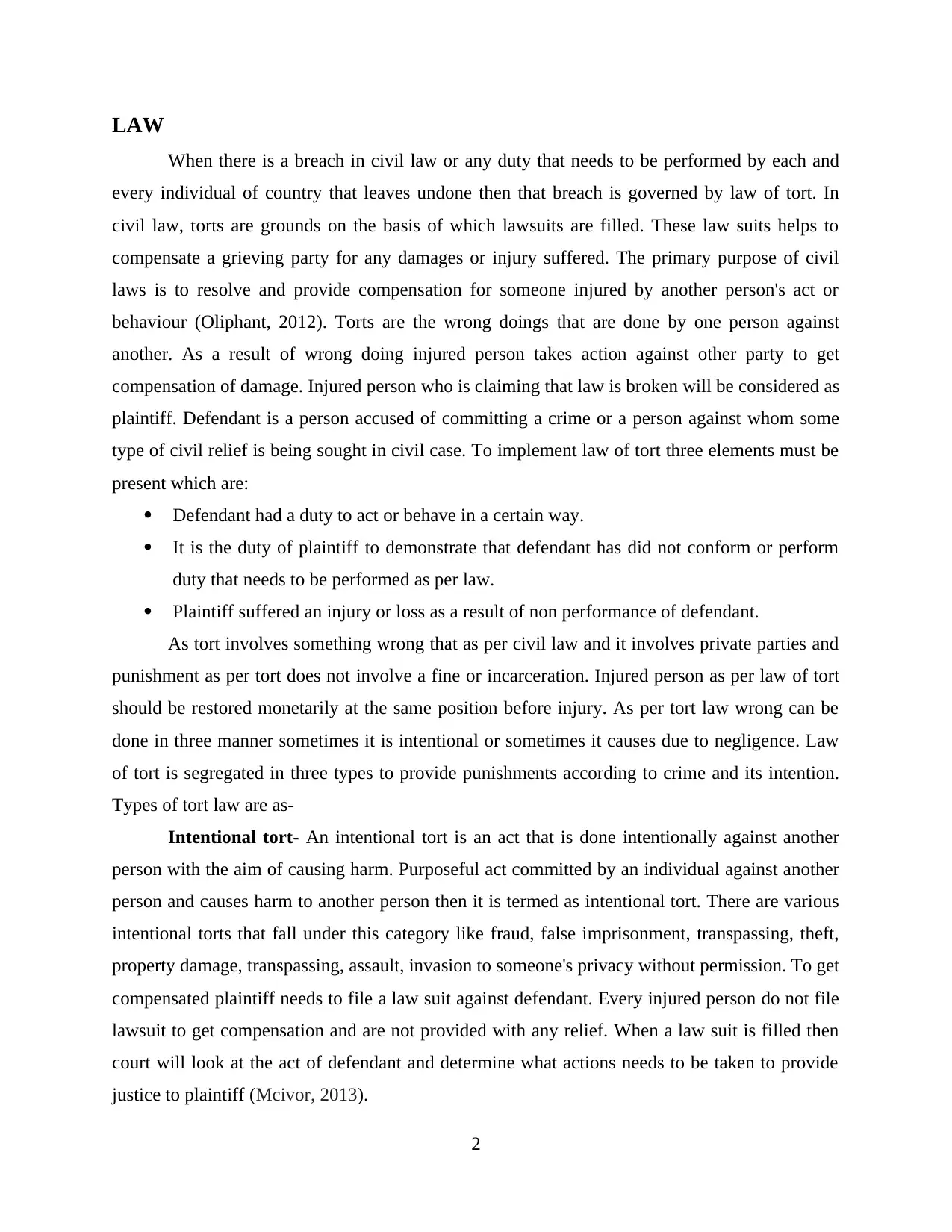
LAW
When there is a breach in civil law or any duty that needs to be performed by each and
every individual of country that leaves undone then that breach is governed by law of tort. In
civil law, torts are grounds on the basis of which lawsuits are filled. These law suits helps to
compensate a grieving party for any damages or injury suffered. The primary purpose of civil
laws is to resolve and provide compensation for someone injured by another person's act or
behaviour (Oliphant, 2012). Torts are the wrong doings that are done by one person against
another. As a result of wrong doing injured person takes action against other party to get
compensation of damage. Injured person who is claiming that law is broken will be considered as
plaintiff. Defendant is a person accused of committing a crime or a person against whom some
type of civil relief is being sought in civil case. To implement law of tort three elements must be
present which are:
Defendant had a duty to act or behave in a certain way.
It is the duty of plaintiff to demonstrate that defendant has did not conform or perform
duty that needs to be performed as per law.
Plaintiff suffered an injury or loss as a result of non performance of defendant.
As tort involves something wrong that as per civil law and it involves private parties and
punishment as per tort does not involve a fine or incarceration. Injured person as per law of tort
should be restored monetarily at the same position before injury. As per tort law wrong can be
done in three manner sometimes it is intentional or sometimes it causes due to negligence. Law
of tort is segregated in three types to provide punishments according to crime and its intention.
Types of tort law are as-
Intentional tort- An intentional tort is an act that is done intentionally against another
person with the aim of causing harm. Purposeful act committed by an individual against another
person and causes harm to another person then it is termed as intentional tort. There are various
intentional torts that fall under this category like fraud, false imprisonment, transpassing, theft,
property damage, transpassing, assault, invasion to someone's privacy without permission. To get
compensated plaintiff needs to file a law suit against defendant. Every injured person do not file
lawsuit to get compensation and are not provided with any relief. When a law suit is filled then
court will look at the act of defendant and determine what actions needs to be taken to provide
justice to plaintiff (Mcivor, 2013).
2
When there is a breach in civil law or any duty that needs to be performed by each and
every individual of country that leaves undone then that breach is governed by law of tort. In
civil law, torts are grounds on the basis of which lawsuits are filled. These law suits helps to
compensate a grieving party for any damages or injury suffered. The primary purpose of civil
laws is to resolve and provide compensation for someone injured by another person's act or
behaviour (Oliphant, 2012). Torts are the wrong doings that are done by one person against
another. As a result of wrong doing injured person takes action against other party to get
compensation of damage. Injured person who is claiming that law is broken will be considered as
plaintiff. Defendant is a person accused of committing a crime or a person against whom some
type of civil relief is being sought in civil case. To implement law of tort three elements must be
present which are:
Defendant had a duty to act or behave in a certain way.
It is the duty of plaintiff to demonstrate that defendant has did not conform or perform
duty that needs to be performed as per law.
Plaintiff suffered an injury or loss as a result of non performance of defendant.
As tort involves something wrong that as per civil law and it involves private parties and
punishment as per tort does not involve a fine or incarceration. Injured person as per law of tort
should be restored monetarily at the same position before injury. As per tort law wrong can be
done in three manner sometimes it is intentional or sometimes it causes due to negligence. Law
of tort is segregated in three types to provide punishments according to crime and its intention.
Types of tort law are as-
Intentional tort- An intentional tort is an act that is done intentionally against another
person with the aim of causing harm. Purposeful act committed by an individual against another
person and causes harm to another person then it is termed as intentional tort. There are various
intentional torts that fall under this category like fraud, false imprisonment, transpassing, theft,
property damage, transpassing, assault, invasion to someone's privacy without permission. To get
compensated plaintiff needs to file a law suit against defendant. Every injured person do not file
lawsuit to get compensation and are not provided with any relief. When a law suit is filled then
court will look at the act of defendant and determine what actions needs to be taken to provide
justice to plaintiff (Mcivor, 2013).
2
Paraphrase This Document
Need a fresh take? Get an instant paraphrase of this document with our AI Paraphraser
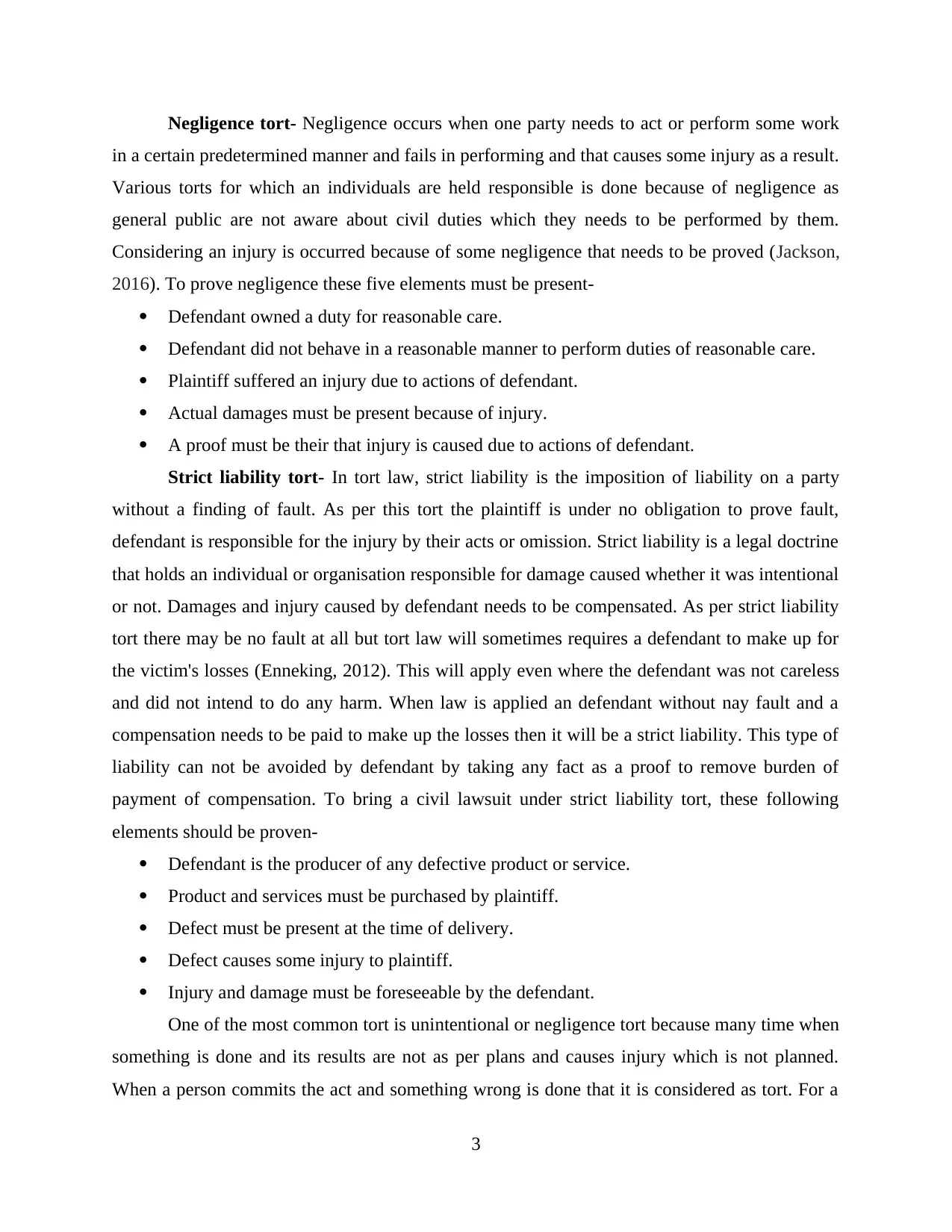
Negligence tort- Negligence occurs when one party needs to act or perform some work
in a certain predetermined manner and fails in performing and that causes some injury as a result.
Various torts for which an individuals are held responsible is done because of negligence as
general public are not aware about civil duties which they needs to be performed by them.
Considering an injury is occurred because of some negligence that needs to be proved (Jackson,
2016). To prove negligence these five elements must be present-
Defendant owned a duty for reasonable care.
Defendant did not behave in a reasonable manner to perform duties of reasonable care.
Plaintiff suffered an injury due to actions of defendant.
Actual damages must be present because of injury.
A proof must be their that injury is caused due to actions of defendant.
Strict liability tort- In tort law, strict liability is the imposition of liability on a party
without a finding of fault. As per this tort the plaintiff is under no obligation to prove fault,
defendant is responsible for the injury by their acts or omission. Strict liability is a legal doctrine
that holds an individual or organisation responsible for damage caused whether it was intentional
or not. Damages and injury caused by defendant needs to be compensated. As per strict liability
tort there may be no fault at all but tort law will sometimes requires a defendant to make up for
the victim's losses (Enneking, 2012). This will apply even where the defendant was not careless
and did not intend to do any harm. When law is applied an defendant without nay fault and a
compensation needs to be paid to make up the losses then it will be a strict liability. This type of
liability can not be avoided by defendant by taking any fact as a proof to remove burden of
payment of compensation. To bring a civil lawsuit under strict liability tort, these following
elements should be proven-
Defendant is the producer of any defective product or service.
Product and services must be purchased by plaintiff.
Defect must be present at the time of delivery.
Defect causes some injury to plaintiff.
Injury and damage must be foreseeable by the defendant.
One of the most common tort is unintentional or negligence tort because many time when
something is done and its results are not as per plans and causes injury which is not planned.
When a person commits the act and something wrong is done that it is considered as tort. For a
3
in a certain predetermined manner and fails in performing and that causes some injury as a result.
Various torts for which an individuals are held responsible is done because of negligence as
general public are not aware about civil duties which they needs to be performed by them.
Considering an injury is occurred because of some negligence that needs to be proved (Jackson,
2016). To prove negligence these five elements must be present-
Defendant owned a duty for reasonable care.
Defendant did not behave in a reasonable manner to perform duties of reasonable care.
Plaintiff suffered an injury due to actions of defendant.
Actual damages must be present because of injury.
A proof must be their that injury is caused due to actions of defendant.
Strict liability tort- In tort law, strict liability is the imposition of liability on a party
without a finding of fault. As per this tort the plaintiff is under no obligation to prove fault,
defendant is responsible for the injury by their acts or omission. Strict liability is a legal doctrine
that holds an individual or organisation responsible for damage caused whether it was intentional
or not. Damages and injury caused by defendant needs to be compensated. As per strict liability
tort there may be no fault at all but tort law will sometimes requires a defendant to make up for
the victim's losses (Enneking, 2012). This will apply even where the defendant was not careless
and did not intend to do any harm. When law is applied an defendant without nay fault and a
compensation needs to be paid to make up the losses then it will be a strict liability. This type of
liability can not be avoided by defendant by taking any fact as a proof to remove burden of
payment of compensation. To bring a civil lawsuit under strict liability tort, these following
elements should be proven-
Defendant is the producer of any defective product or service.
Product and services must be purchased by plaintiff.
Defect must be present at the time of delivery.
Defect causes some injury to plaintiff.
Injury and damage must be foreseeable by the defendant.
One of the most common tort is unintentional or negligence tort because many time when
something is done and its results are not as per plans and causes injury which is not planned.
When a person commits the act and something wrong is done that it is considered as tort. For a
3
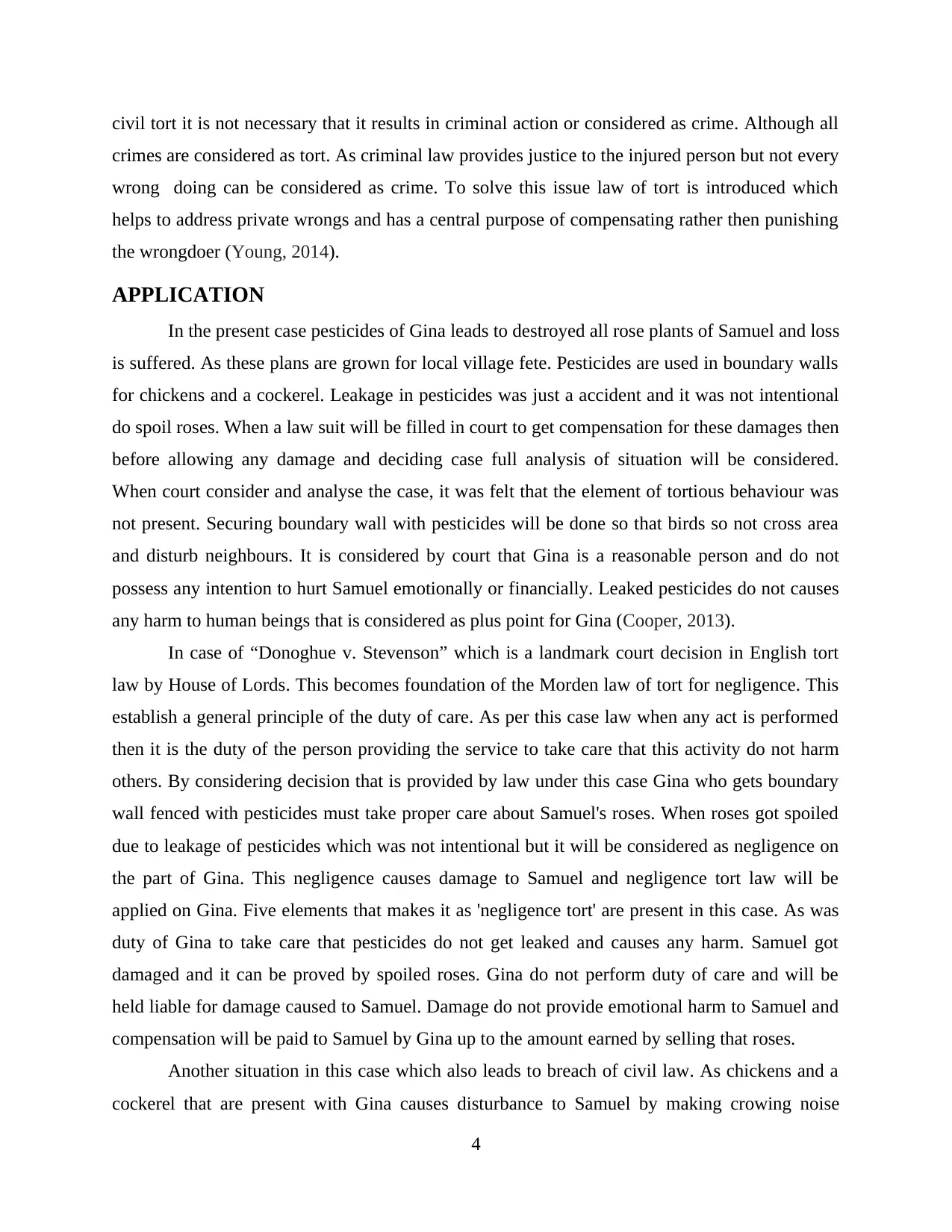
civil tort it is not necessary that it results in criminal action or considered as crime. Although all
crimes are considered as tort. As criminal law provides justice to the injured person but not every
wrong doing can be considered as crime. To solve this issue law of tort is introduced which
helps to address private wrongs and has a central purpose of compensating rather then punishing
the wrongdoer (Young, 2014).
APPLICATION
In the present case pesticides of Gina leads to destroyed all rose plants of Samuel and loss
is suffered. As these plans are grown for local village fete. Pesticides are used in boundary walls
for chickens and a cockerel. Leakage in pesticides was just a accident and it was not intentional
do spoil roses. When a law suit will be filled in court to get compensation for these damages then
before allowing any damage and deciding case full analysis of situation will be considered.
When court consider and analyse the case, it was felt that the element of tortious behaviour was
not present. Securing boundary wall with pesticides will be done so that birds so not cross area
and disturb neighbours. It is considered by court that Gina is a reasonable person and do not
possess any intention to hurt Samuel emotionally or financially. Leaked pesticides do not causes
any harm to human beings that is considered as plus point for Gina (Cooper, 2013).
In case of “Donoghue v. Stevenson” which is a landmark court decision in English tort
law by House of Lords. This becomes foundation of the Morden law of tort for negligence. This
establish a general principle of the duty of care. As per this case law when any act is performed
then it is the duty of the person providing the service to take care that this activity do not harm
others. By considering decision that is provided by law under this case Gina who gets boundary
wall fenced with pesticides must take proper care about Samuel's roses. When roses got spoiled
due to leakage of pesticides which was not intentional but it will be considered as negligence on
the part of Gina. This negligence causes damage to Samuel and negligence tort law will be
applied on Gina. Five elements that makes it as 'negligence tort' are present in this case. As was
duty of Gina to take care that pesticides do not get leaked and causes any harm. Samuel got
damaged and it can be proved by spoiled roses. Gina do not perform duty of care and will be
held liable for damage caused to Samuel. Damage do not provide emotional harm to Samuel and
compensation will be paid to Samuel by Gina up to the amount earned by selling that roses.
Another situation in this case which also leads to breach of civil law. As chickens and a
cockerel that are present with Gina causes disturbance to Samuel by making crowing noise
4
crimes are considered as tort. As criminal law provides justice to the injured person but not every
wrong doing can be considered as crime. To solve this issue law of tort is introduced which
helps to address private wrongs and has a central purpose of compensating rather then punishing
the wrongdoer (Young, 2014).
APPLICATION
In the present case pesticides of Gina leads to destroyed all rose plants of Samuel and loss
is suffered. As these plans are grown for local village fete. Pesticides are used in boundary walls
for chickens and a cockerel. Leakage in pesticides was just a accident and it was not intentional
do spoil roses. When a law suit will be filled in court to get compensation for these damages then
before allowing any damage and deciding case full analysis of situation will be considered.
When court consider and analyse the case, it was felt that the element of tortious behaviour was
not present. Securing boundary wall with pesticides will be done so that birds so not cross area
and disturb neighbours. It is considered by court that Gina is a reasonable person and do not
possess any intention to hurt Samuel emotionally or financially. Leaked pesticides do not causes
any harm to human beings that is considered as plus point for Gina (Cooper, 2013).
In case of “Donoghue v. Stevenson” which is a landmark court decision in English tort
law by House of Lords. This becomes foundation of the Morden law of tort for negligence. This
establish a general principle of the duty of care. As per this case law when any act is performed
then it is the duty of the person providing the service to take care that this activity do not harm
others. By considering decision that is provided by law under this case Gina who gets boundary
wall fenced with pesticides must take proper care about Samuel's roses. When roses got spoiled
due to leakage of pesticides which was not intentional but it will be considered as negligence on
the part of Gina. This negligence causes damage to Samuel and negligence tort law will be
applied on Gina. Five elements that makes it as 'negligence tort' are present in this case. As was
duty of Gina to take care that pesticides do not get leaked and causes any harm. Samuel got
damaged and it can be proved by spoiled roses. Gina do not perform duty of care and will be
held liable for damage caused to Samuel. Damage do not provide emotional harm to Samuel and
compensation will be paid to Samuel by Gina up to the amount earned by selling that roses.
Another situation in this case which also leads to breach of civil law. As chickens and a
cockerel that are present with Gina causes disturbance to Samuel by making crowing noise
4
⊘ This is a preview!⊘
Do you want full access?
Subscribe today to unlock all pages.

Trusted by 1+ million students worldwide
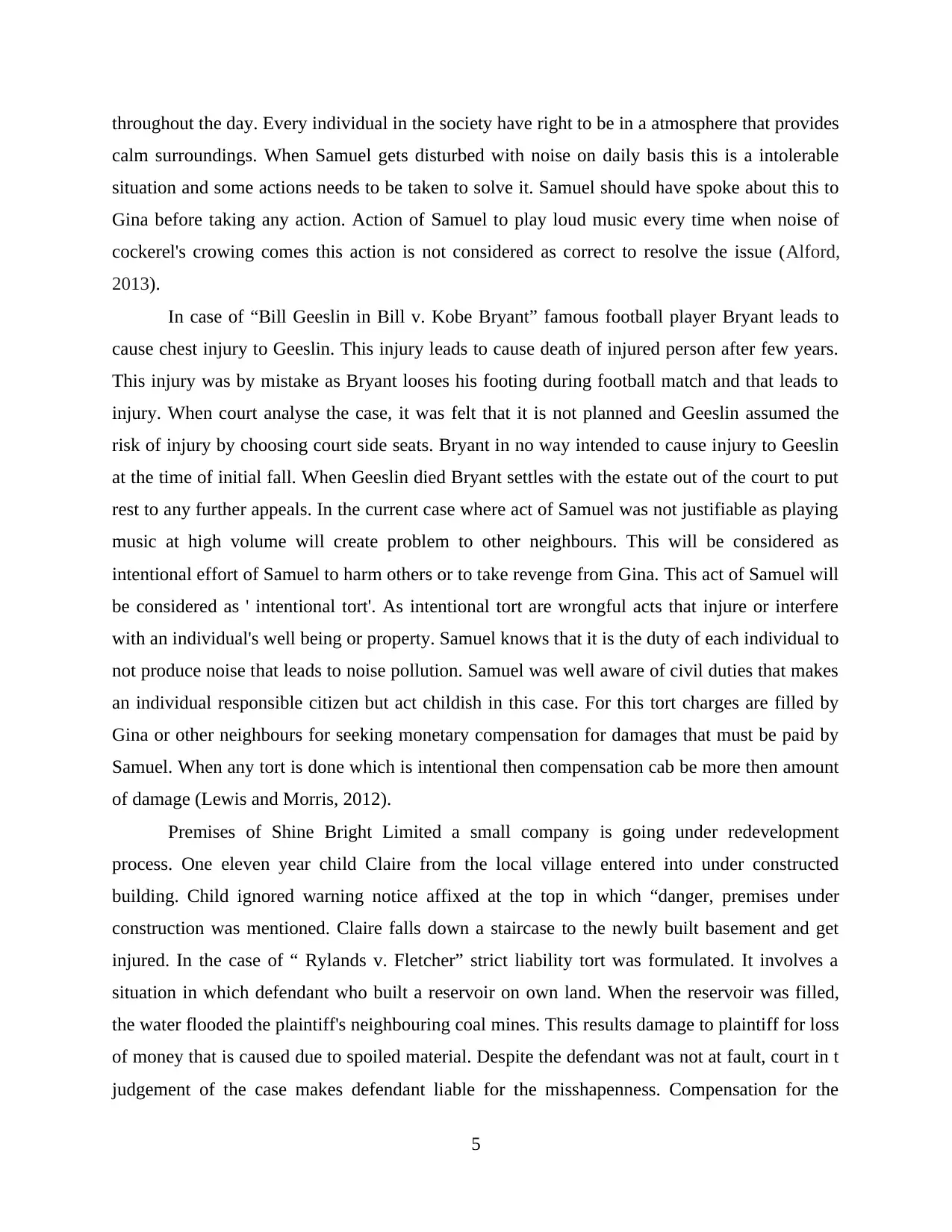
throughout the day. Every individual in the society have right to be in a atmosphere that provides
calm surroundings. When Samuel gets disturbed with noise on daily basis this is a intolerable
situation and some actions needs to be taken to solve it. Samuel should have spoke about this to
Gina before taking any action. Action of Samuel to play loud music every time when noise of
cockerel's crowing comes this action is not considered as correct to resolve the issue (Alford,
2013).
In case of “Bill Geeslin in Bill v. Kobe Bryant” famous football player Bryant leads to
cause chest injury to Geeslin. This injury leads to cause death of injured person after few years.
This injury was by mistake as Bryant looses his footing during football match and that leads to
injury. When court analyse the case, it was felt that it is not planned and Geeslin assumed the
risk of injury by choosing court side seats. Bryant in no way intended to cause injury to Geeslin
at the time of initial fall. When Geeslin died Bryant settles with the estate out of the court to put
rest to any further appeals. In the current case where act of Samuel was not justifiable as playing
music at high volume will create problem to other neighbours. This will be considered as
intentional effort of Samuel to harm others or to take revenge from Gina. This act of Samuel will
be considered as ' intentional tort'. As intentional tort are wrongful acts that injure or interfere
with an individual's well being or property. Samuel knows that it is the duty of each individual to
not produce noise that leads to noise pollution. Samuel was well aware of civil duties that makes
an individual responsible citizen but act childish in this case. For this tort charges are filled by
Gina or other neighbours for seeking monetary compensation for damages that must be paid by
Samuel. When any tort is done which is intentional then compensation cab be more then amount
of damage (Lewis and Morris, 2012).
Premises of Shine Bright Limited a small company is going under redevelopment
process. One eleven year child Claire from the local village entered into under constructed
building. Child ignored warning notice affixed at the top in which “danger, premises under
construction was mentioned. Claire falls down a staircase to the newly built basement and get
injured. In the case of “ Rylands v. Fletcher” strict liability tort was formulated. It involves a
situation in which defendant who built a reservoir on own land. When the reservoir was filled,
the water flooded the plaintiff's neighbouring coal mines. This results damage to plaintiff for loss
of money that is caused due to spoiled material. Despite the defendant was not at fault, court in t
judgement of the case makes defendant liable for the misshapenness. Compensation for the
5
calm surroundings. When Samuel gets disturbed with noise on daily basis this is a intolerable
situation and some actions needs to be taken to solve it. Samuel should have spoke about this to
Gina before taking any action. Action of Samuel to play loud music every time when noise of
cockerel's crowing comes this action is not considered as correct to resolve the issue (Alford,
2013).
In case of “Bill Geeslin in Bill v. Kobe Bryant” famous football player Bryant leads to
cause chest injury to Geeslin. This injury leads to cause death of injured person after few years.
This injury was by mistake as Bryant looses his footing during football match and that leads to
injury. When court analyse the case, it was felt that it is not planned and Geeslin assumed the
risk of injury by choosing court side seats. Bryant in no way intended to cause injury to Geeslin
at the time of initial fall. When Geeslin died Bryant settles with the estate out of the court to put
rest to any further appeals. In the current case where act of Samuel was not justifiable as playing
music at high volume will create problem to other neighbours. This will be considered as
intentional effort of Samuel to harm others or to take revenge from Gina. This act of Samuel will
be considered as ' intentional tort'. As intentional tort are wrongful acts that injure or interfere
with an individual's well being or property. Samuel knows that it is the duty of each individual to
not produce noise that leads to noise pollution. Samuel was well aware of civil duties that makes
an individual responsible citizen but act childish in this case. For this tort charges are filled by
Gina or other neighbours for seeking monetary compensation for damages that must be paid by
Samuel. When any tort is done which is intentional then compensation cab be more then amount
of damage (Lewis and Morris, 2012).
Premises of Shine Bright Limited a small company is going under redevelopment
process. One eleven year child Claire from the local village entered into under constructed
building. Child ignored warning notice affixed at the top in which “danger, premises under
construction was mentioned. Claire falls down a staircase to the newly built basement and get
injured. In the case of “ Rylands v. Fletcher” strict liability tort was formulated. It involves a
situation in which defendant who built a reservoir on own land. When the reservoir was filled,
the water flooded the plaintiff's neighbouring coal mines. This results damage to plaintiff for loss
of money that is caused due to spoiled material. Despite the defendant was not at fault, court in t
judgement of the case makes defendant liable for the misshapenness. Compensation for the
5
Paraphrase This Document
Need a fresh take? Get an instant paraphrase of this document with our AI Paraphraser
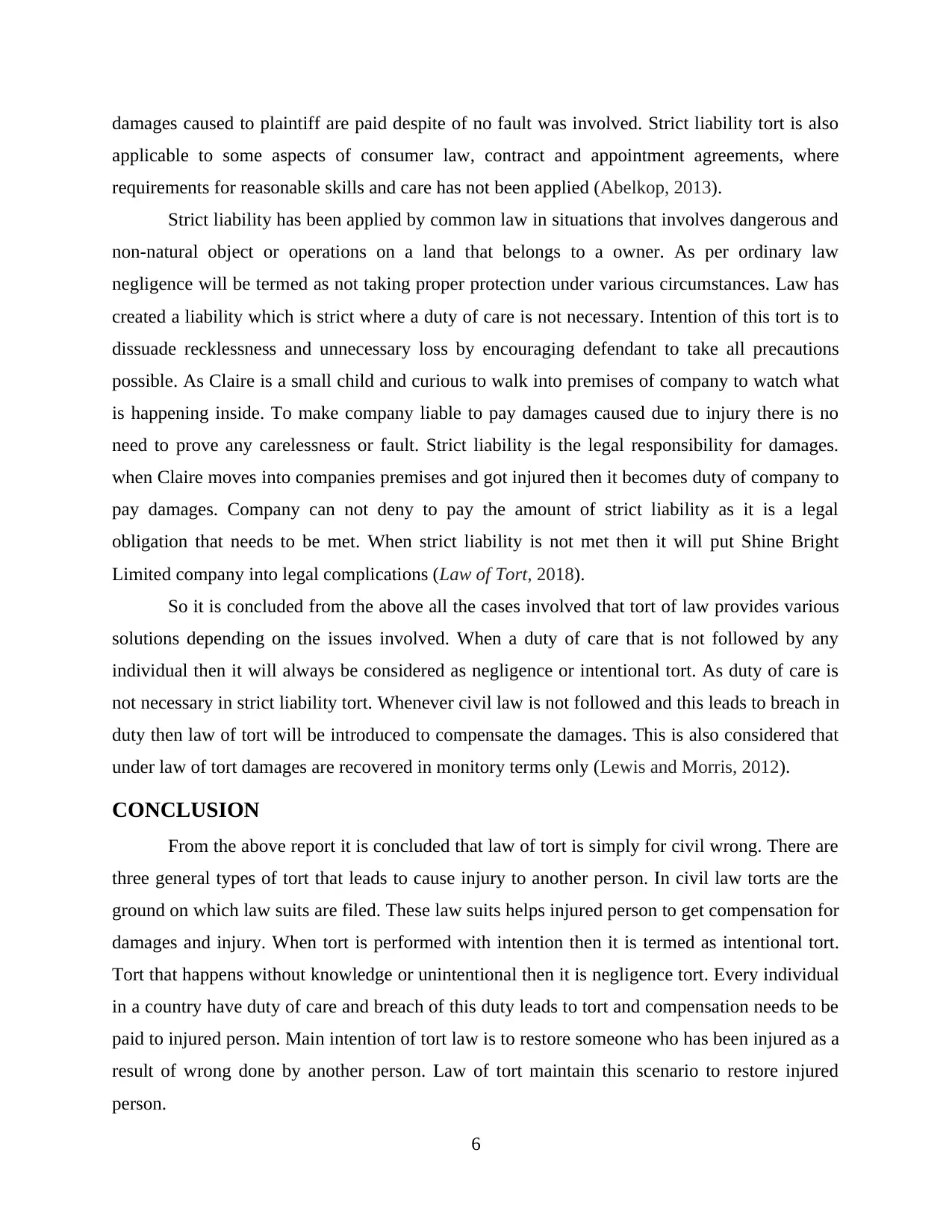
damages caused to plaintiff are paid despite of no fault was involved. Strict liability tort is also
applicable to some aspects of consumer law, contract and appointment agreements, where
requirements for reasonable skills and care has not been applied (Abelkop, 2013).
Strict liability has been applied by common law in situations that involves dangerous and
non-natural object or operations on a land that belongs to a owner. As per ordinary law
negligence will be termed as not taking proper protection under various circumstances. Law has
created a liability which is strict where a duty of care is not necessary. Intention of this tort is to
dissuade recklessness and unnecessary loss by encouraging defendant to take all precautions
possible. As Claire is a small child and curious to walk into premises of company to watch what
is happening inside. To make company liable to pay damages caused due to injury there is no
need to prove any carelessness or fault. Strict liability is the legal responsibility for damages.
when Claire moves into companies premises and got injured then it becomes duty of company to
pay damages. Company can not deny to pay the amount of strict liability as it is a legal
obligation that needs to be met. When strict liability is not met then it will put Shine Bright
Limited company into legal complications (Law of Tort, 2018).
So it is concluded from the above all the cases involved that tort of law provides various
solutions depending on the issues involved. When a duty of care that is not followed by any
individual then it will always be considered as negligence or intentional tort. As duty of care is
not necessary in strict liability tort. Whenever civil law is not followed and this leads to breach in
duty then law of tort will be introduced to compensate the damages. This is also considered that
under law of tort damages are recovered in monitory terms only (Lewis and Morris, 2012).
CONCLUSION
From the above report it is concluded that law of tort is simply for civil wrong. There are
three general types of tort that leads to cause injury to another person. In civil law torts are the
ground on which law suits are filed. These law suits helps injured person to get compensation for
damages and injury. When tort is performed with intention then it is termed as intentional tort.
Tort that happens without knowledge or unintentional then it is negligence tort. Every individual
in a country have duty of care and breach of this duty leads to tort and compensation needs to be
paid to injured person. Main intention of tort law is to restore someone who has been injured as a
result of wrong done by another person. Law of tort maintain this scenario to restore injured
person.
6
applicable to some aspects of consumer law, contract and appointment agreements, where
requirements for reasonable skills and care has not been applied (Abelkop, 2013).
Strict liability has been applied by common law in situations that involves dangerous and
non-natural object or operations on a land that belongs to a owner. As per ordinary law
negligence will be termed as not taking proper protection under various circumstances. Law has
created a liability which is strict where a duty of care is not necessary. Intention of this tort is to
dissuade recklessness and unnecessary loss by encouraging defendant to take all precautions
possible. As Claire is a small child and curious to walk into premises of company to watch what
is happening inside. To make company liable to pay damages caused due to injury there is no
need to prove any carelessness or fault. Strict liability is the legal responsibility for damages.
when Claire moves into companies premises and got injured then it becomes duty of company to
pay damages. Company can not deny to pay the amount of strict liability as it is a legal
obligation that needs to be met. When strict liability is not met then it will put Shine Bright
Limited company into legal complications (Law of Tort, 2018).
So it is concluded from the above all the cases involved that tort of law provides various
solutions depending on the issues involved. When a duty of care that is not followed by any
individual then it will always be considered as negligence or intentional tort. As duty of care is
not necessary in strict liability tort. Whenever civil law is not followed and this leads to breach in
duty then law of tort will be introduced to compensate the damages. This is also considered that
under law of tort damages are recovered in monitory terms only (Lewis and Morris, 2012).
CONCLUSION
From the above report it is concluded that law of tort is simply for civil wrong. There are
three general types of tort that leads to cause injury to another person. In civil law torts are the
ground on which law suits are filed. These law suits helps injured person to get compensation for
damages and injury. When tort is performed with intention then it is termed as intentional tort.
Tort that happens without knowledge or unintentional then it is negligence tort. Every individual
in a country have duty of care and breach of this duty leads to tort and compensation needs to be
paid to injured person. Main intention of tort law is to restore someone who has been injured as a
result of wrong done by another person. Law of tort maintain this scenario to restore injured
person.
6
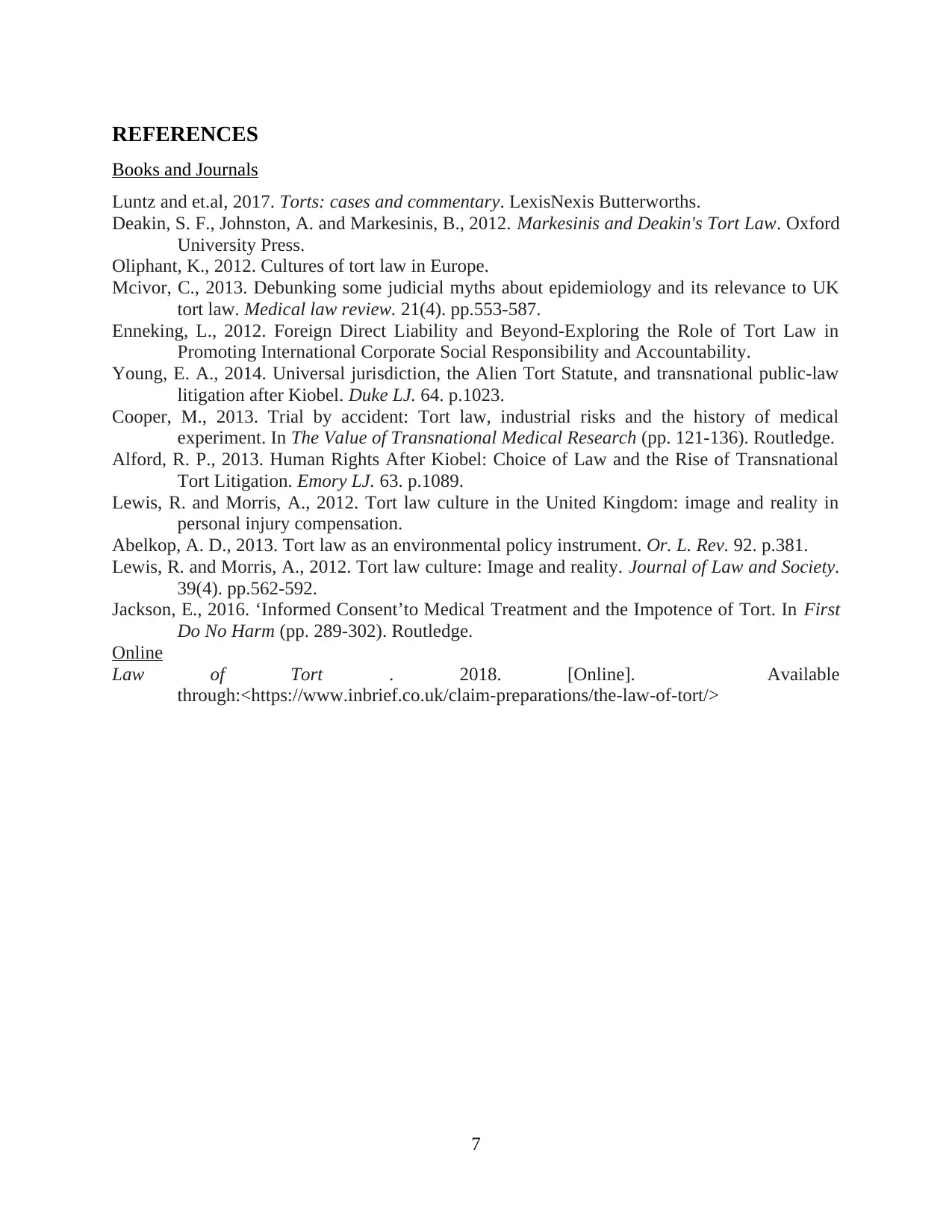
REFERENCES
Books and Journals
Luntz and et.al, 2017. Torts: cases and commentary. LexisNexis Butterworths.
Deakin, S. F., Johnston, A. and Markesinis, B., 2012. Markesinis and Deakin's Tort Law. Oxford
University Press.
Oliphant, K., 2012. Cultures of tort law in Europe.
Mcivor, C., 2013. Debunking some judicial myths about epidemiology and its relevance to UK
tort law. Medical law review. 21(4). pp.553-587.
Enneking, L., 2012. Foreign Direct Liability and Beyond-Exploring the Role of Tort Law in
Promoting International Corporate Social Responsibility and Accountability.
Young, E. A., 2014. Universal jurisdiction, the Alien Tort Statute, and transnational public-law
litigation after Kiobel. Duke LJ. 64. p.1023.
Cooper, M., 2013. Trial by accident: Tort law, industrial risks and the history of medical
experiment. In The Value of Transnational Medical Research (pp. 121-136). Routledge.
Alford, R. P., 2013. Human Rights After Kiobel: Choice of Law and the Rise of Transnational
Tort Litigation. Emory LJ. 63. p.1089.
Lewis, R. and Morris, A., 2012. Tort law culture in the United Kingdom: image and reality in
personal injury compensation.
Abelkop, A. D., 2013. Tort law as an environmental policy instrument. Or. L. Rev. 92. p.381.
Lewis, R. and Morris, A., 2012. Tort law culture: Image and reality. Journal of Law and Society.
39(4). pp.562-592.
Jackson, E., 2016. ‘Informed Consent’to Medical Treatment and the Impotence of Tort. In First
Do No Harm (pp. 289-302). Routledge.
Online
Law of Tort . 2018. [Online]. Available
through:<https://www.inbrief.co.uk/claim-preparations/the-law-of-tort/>
7
Books and Journals
Luntz and et.al, 2017. Torts: cases and commentary. LexisNexis Butterworths.
Deakin, S. F., Johnston, A. and Markesinis, B., 2012. Markesinis and Deakin's Tort Law. Oxford
University Press.
Oliphant, K., 2012. Cultures of tort law in Europe.
Mcivor, C., 2013. Debunking some judicial myths about epidemiology and its relevance to UK
tort law. Medical law review. 21(4). pp.553-587.
Enneking, L., 2012. Foreign Direct Liability and Beyond-Exploring the Role of Tort Law in
Promoting International Corporate Social Responsibility and Accountability.
Young, E. A., 2014. Universal jurisdiction, the Alien Tort Statute, and transnational public-law
litigation after Kiobel. Duke LJ. 64. p.1023.
Cooper, M., 2013. Trial by accident: Tort law, industrial risks and the history of medical
experiment. In The Value of Transnational Medical Research (pp. 121-136). Routledge.
Alford, R. P., 2013. Human Rights After Kiobel: Choice of Law and the Rise of Transnational
Tort Litigation. Emory LJ. 63. p.1089.
Lewis, R. and Morris, A., 2012. Tort law culture in the United Kingdom: image and reality in
personal injury compensation.
Abelkop, A. D., 2013. Tort law as an environmental policy instrument. Or. L. Rev. 92. p.381.
Lewis, R. and Morris, A., 2012. Tort law culture: Image and reality. Journal of Law and Society.
39(4). pp.562-592.
Jackson, E., 2016. ‘Informed Consent’to Medical Treatment and the Impotence of Tort. In First
Do No Harm (pp. 289-302). Routledge.
Online
Law of Tort . 2018. [Online]. Available
through:<https://www.inbrief.co.uk/claim-preparations/the-law-of-tort/>
7
⊘ This is a preview!⊘
Do you want full access?
Subscribe today to unlock all pages.

Trusted by 1+ million students worldwide
1 out of 9
Related Documents
Your All-in-One AI-Powered Toolkit for Academic Success.
+13062052269
info@desklib.com
Available 24*7 on WhatsApp / Email
![[object Object]](/_next/static/media/star-bottom.7253800d.svg)
Unlock your academic potential
Copyright © 2020–2025 A2Z Services. All Rights Reserved. Developed and managed by ZUCOL.




